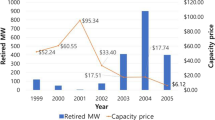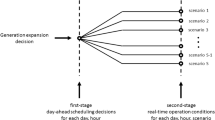Abstract
Recently, the European Commission passed the Guideline on Electricity Balancing to standardize future reserve products in European electricity markets. Strict regulatory requirements are imposed on ramping behavior that must be adhered to, which brings ramping constraints into renewed focus. In a literature review, we find that prevalent ramping constraint formulations cannot guarantee that those regulatory requirements are fully satisfied. Since reserve activation in relation to ramping constraints is not discussed in literature, we aim to fill this research gap with a focus on the impact of reserve activation on ramping feasibility, availability of reserve, and thereby induced imbalances. We argue for the use of a simple, yet consequential and more robust, extended version of ramping constraints to account for intertemporal dependencies of reserve in general and to satisfy regulatory requirements in particular. Prevalent formulations significantly overestimate available reserve compared to the robust formulation. Worst-case bounds on the overestimation factor are provided for common operating modes. Computational experiments on standard benchmark sets confirm that the prevalent formulation overestimates reserve in realistic scenarios. Reserve activations are simulated from German data in a comprehensive ex-post analysis to identify reserve overestimation as a hitherto neglected source of imbalances and to quantify its extent.











Similar content being viewed by others
Notes
Many papers consider positive reserve only. In those papers, the notation for reserve is \(r_{t}\), which is the same as \(r_{t}^{+}\) in this paper. Sometimes the maximum power available of the power plant is denoted as \(\overline{y}_{t}\), s.t. \(\overline{y}_{t}=y_{t}+r_{t}\).
References
Abujarad SY, Mustafa M, Jamian J (2017) Recent approaches of unit commitment in the presence of intermittent renewable energy resources: a review. Renew Sustain Energy Rev 70:215–223. https://doi.org/10.1016/j.rser.2016.11.246
Aminifar F, Fotuhi-Firuzabad M, Shahidehpour M (2009) Unit commitment with probabilistic spinning reserve and interruptible load considerations. IEEE Trans Power Syst 24(1):388–397. https://doi.org/10.1109/TPWRS.2008.2008675
Arroyo JM, Conejo AJ (2000) Optimal response of a thermal unit to an electricity spot market. IEEE Trans Power Syst 15(3):1098–1104. https://doi.org/10.1109/59.871739
Arroyo JM, Conejo AJ (2002) Optimal response of a power generator to energy, AGC, and reserve pool-based markets. IEEE Trans Power Syst 17(2):404–410. https://doi.org/10.1109/TPWRS.2002.1007910
Arroyo JM, Conejo AJ (2004) Modeling of start-up and shut-down power trajectories of thermal units. IEEE Trans Power Syst 19(3):1562–1568. https://doi.org/10.1109/TPWRS.2004.831654
Attaviriyanupap P, Kita H, Tanaka E, Hasegawa J (2005) New bidding strategy formulation for day-ahead energy and reserve markets based on evolutionary programming. Int J Electr Power Energy Syst 27(3):157–167. https://doi.org/10.1016/j.ijepes.2004.09.005
Barrows C, Bloom A, Ehlen A, Ikäheimo J, Jorgenson J, Krishnamurthy D, Lau J, McBennett B, O’Connell M, Preston E et al (2019) The IEEE reliability test system: a proposed 2019 update. IEEE Trans Power Syst 35(1):119–127. https://doi.org/10.1109/TPWRS.2019.2925557
Carrion M, Arroyo JM (2006) A computationally efficient mixed-integer linear formulation for the thermal unit commitment problem. IEEE Trans Power Syst 21(3):1371–1378. https://doi.org/10.1109/TPWRS.2006.876672
Castillo A, Laird C, Silva-Monroy CA, Watson JP, O’Neill RP (2016) The unit commitment problem with ac optimal power flow constraints. IEEE Trans Power Syst 31(6):4853–4866. https://doi.org/10.1109/TPWRS.2015.2511010
Commission regulation (EU) (2017) 2017/2195 of 23 november 2017 establishing a guideline on electricity balancing
Correa-Posada CM, Morales-España G, Dueñas P, Sánchez-Martín P (2017) Dynamic ramping model including intraperiod ramp-rate changes in unit commitment. IEEETrans Sustain Energy 8(1):43–50. https://doi.org/10.1109/TSTE.2016.2578302
Costley M, Feizollahi MJ, Ahmed S, Grijalva S (2017) A rolling-horizon unit commitment framework with flexible periodicity. Int J Electr Power Energy Syst 90:280–291. https://doi.org/10.1016/j.ijepes.2017.01.026
Dillon TS, Edwin KW, Kochs HD, Taud RJ (1978) Integer programming approach to the problem of optimal unit commitment with probabilistic reserve determination. IEEE Trans Power Apparatus Syst 97(6):2154–2166. https://doi.org/10.1109/TPAS.1978.354719
ENTSO‑E, EURELECTRIC (2011) Deterministic frequency deviations—Root causes and proposals for potential solutions
ENTSO‑E (2017) Proposal for standard products—draft. https://docstore.entsoe.eu/Documents/MC%20documents/balancing_ancillary/2017-03-07/161123_WGAS_Draft_proposal_for_Standard_Products.pdf. Accessed 06 July 2021
ENTSO‑E (2020) Continental europe operation handbook. https://www.entsoe.eu/publications/system-operations-reports/operation-handbook/Pages/default.aspx. Accessed: 06 July 2021
Garver LL (1962) Power generation scheduling by integer programming—Development of theory. Trans AIEE Part Iii Power Appar Syst 81(3):730–734. https://doi.org/10.1109/AIEEPAS.1962.4501405
Gentile C, Morales-España G, Ramos A (2017) A tight MIP formulation of the unit commitment problem with start-up and shut-down constraints. Euro J Comput Optim 5(1):177–201. https://doi.org/10.1007/s13675-016-0066-y
Hua B, Baldick R, Wang J (2017) Representing operational flexibility in generation expansion planning through convex relaxation of unit commitment. IEEE Trans Power Syst 33(2):2272–2281. https://doi.org/10.1109/TPWRS.2017.2735026
Knueven B, Ostrowski J, Wang J (2018) The ramping polytope and cut generation for the unit commitment problem. INFORMS J Comput 30(4):739–749. https://doi.org/10.1287/ijoc.2017.0802
Knueven B, Ostrowski J, Watson JP (2020) On mixed-integer programming formulations for the unit commitment problem. INFORMS J Comput. https://doi.org/10.1287/ijoc.2019.0944
Koltsaklis NE, Dagoumas AS (2018) Incorporating unit commitment aspects to the european electricity markets algorithm: an optimization model for the joint clearing of energy and reserve markets. Appl Energy 231:235–258. https://doi.org/10.1016/j.apenergy.2018.09.098
Krall E, Higgins M, O’Neill RP (2012) RTO unit commitment test system. Federal Energy Regulatory Commission 98. https://github.com/power-grid-lib/pglib-uc/releases/tag/v19.08. Accessed: 06 July 2021
Kurscheid EM (2009) Zur Bereitstellung positiver Minutenreserve durch dezentrale Klein-KWK-Anlagen. PhD thesis
Kwon R, Frances D (2012) Optimization-based bidding in day-ahead electricity auction markets: a review of models for power producers. In: Handbook of networks in power systems. Springer, Berlin, Heidelberg, New York, pp 41–59 https://doi.org/10.1007/978-3-642-23193-3_2
Li G, Shi J, Qu X (2011) Modeling methods for genco bidding strategy optimization in the liberalized electricity spot market—A state-of-the-art review. Energy 36(8):4686–4700. https://doi.org/10.1016/j.energy.2011.06.015
Mashhour E, Moghaddas-Tafreshi SM (2011) Bidding strategy of virtual power plant for participating in energy and spinning reserve markets—Part i: problem formulation. IEEE Trans Power Syst 26(2):949–956. https://doi.org/10.1109/TPWRS.2010.2070884
Morales-España G, Ramos A, García-González J (2014) An MIP formulation for joint market-clearing of energy and reserves based on ramp scheduling. IEEE Trans Power Syst 29(1):476–488. https://doi.org/10.1109/TPWRS.2013.2259601
Morales-España G, Ramírez-Elizondo L, Hobbs BF (2017) Hidden power system inflexibilities imposed by traditional unit commitment formulations. Appl Energy 191:223–238. https://doi.org/10.1016/j.apenergy.2017.01.089
Ostrowski J, Anjos MF, Vannelli A (2012) Tight mixed integer linear programming formulations for the unit commitment problem. IEEE Trans Power Syst 27(1):39–46. https://doi.org/10.1109/TPWRS.2011.2162008
Pozo D, Contreras J (2013) A chance-constrained unit commitment with an \(n-k\) security criterion and significant wind generation. IEEE Trans Power Syst 28(3):2842–2851. https://doi.org/10.1109/TPWRS.2012.2227841
Prabavathi M, Gnanadass R (2015) Energy bidding strategies for restructured electricity market. Int J Electr Power Energy Syst 64(Supplement C):956–966. https://doi.org/10.1016/j.ijepes.2014.08.018
Quan H, Srinivasan D, Khambadkone AM, Khosravi A (2015) A computational framework for uncertainty integration in stochastic unit commitment with intermittent renewable energy sources. Appl Energy 152:71–82. https://doi.org/10.1016/j.apenergy.2015.04.103
Rebours YG, Kirschen DS (2005) A survey of definitions and specifications of reserve services. Report, University of Manchester, pp 1–38
Rebours YG, Kirschen DS, Trotignon M, Rossignol S (2007a) A survey of frequency and voltage control ancillary services—Part i: Technical features. IEEE Trans Power Syst 22(1):350–357. https://doi.org/10.1109/TPWRS.2006.888963
Rebours YG, Kirschen DS, Trotignon M, Rossignol S (2007b) A survey of frequency and voltage control ancillary services—Part ii: Economic features. IEEE Trans Power Syst 22(1):358–366. https://doi.org/10.1109/TPWRS.2006.888965
Shayegan-Rad A, Badri A, Zangeneh A (2017) Day-ahead scheduling of virtual power plant in joint energy and regulation reserve markets under uncertainties. Energy 121:114–125. https://doi.org/10.1016/j.energy.2017.01.006
Shi L, Luo Y, Tu G (2014) Bidding strategy of microgrid with consideration of uncertainty for participating in power market. Int J Electr Power Energy Syst 59(Supplement C):1–13
Street A, Oliveira F, Arroyo JM (2011) Contingency-constrained unit commitment with \(n-k\) security criterion:a robust optimization approach. IEEE Trans Power Syst 26(3):1581–1590. https://doi.org/10.1109/TPWRS.2010.2087367
Tseng CL, Zhu W (2010) Optimal self-scheduling and bidding strategy of a thermal unit subject to ramp constraints and price uncertainty. IET Gener Transm Distribution 4(2):125–137. https://doi.org/10.1049/iet-gtd.2009.0048
Weißbach T, Remppis S, Lens H (2018) Impact of current market developments in Europe on deterministic grid frequency deviations and frequency restauration reserve demand. In: 2018 15th International Conference on the European Energy Market (EEM), IEEE, pp 1–6 https://doi.org/10.1109/EEM.2018.8469210
Wu H, Liu X, Ding M (2014) Dynamic economic dispatch of a microgrid: mathematical models and solution algorithm. Int J Electr Power Energy Syst 63:336–346. https://doi.org/10.1016/j.ijepes.2014.06.002
Wu H, Shahidehpour M, Al-Abdulwahab A (2013) Hourly demand response in day-ahead scheduling for managing the variability of renewable energy. IET Gener Transm Distribution 7(3):226–234. https://doi.org/10.1049/iet-gtd.2012.0186
Wu H, Shahidehpour M, Khodayar ME (2013) Hourly demand response in day-ahead scheduling considering generating unit ramping cost. IEEE Trans Power Syst 28(3):2446–2454. https://doi.org/10.1109/TPWRS.2013.2254728
Xia X, Elaiw A (2010) Optimal dynamic economic dispatch of generation: a review. Electr Power Syst Res 80(8):975–986. https://doi.org/10.1016/j.epsr.2009.12.012
Yamin H, El-Dwairi Q, Shahidehpour S (2007) A new approach for gencos profit based unit commitment in day-ahead competitive electricity markets considering reserve uncertainty. Int J Electr Power Energy Syst 29(8):609–616. https://doi.org/10.1016/j.ijepes.2006.09.004
Zamani AG, Zakariazadeh A, Jadid S (2016) Day-ahead resource scheduling of a renewable energy based virtual power plant. Appl Energy 169:324–340. https://doi.org/10.1016/j.apenergy.2016.02.011
Author information
Authors and Affiliations
Corresponding author
Additional information
This work was supported by the European Union and the Free State of Saxony under SAB-Nr. 100331224.
Appendices
Derivation of bounds on reserve overestimation
Let \(\Delta_{t}=y_{t}-y_{t-1}\) denote the change in power output. For prevalent ramping constraints (13)–(14),
and for robust ramping constraints (16)–(17),
1.1 Case A—constant power
With constant power output \(\Delta_{t}=0\), \(r_{t}^{+}=r_{t-1}^{+}\), and \(r_{t}^{-}=r_{t-1}^{-}\), the following inequalities hold. For prevalent ramping constraints (24)–(25),
which gives an upper bound on total reserve of
For robust ramping constraints (26)–(27),
s.t.
To determine the factor of reserve overestimation, compare the bound on total reserve of prevalent ramping constraints (30) to that of robust ramping constraints (33). In the worst-case of constant power output, prevalent ramping constraints overestimate total available reserve by a factor of
compared to robust ramping constraints. For symmetric ramping rate limits \(V=\overline{V}=\underline{V}\), the bound on the overestimation factor decreases to \(2V/V=2\).
1.2 Case B—ramping up or down
Apply the same logic as before, assume the plant ramps down with the maximum ramp rate \(\Delta_{t}=-\underline{V}\), and again \(r_{t}^{+}=r_{t-1}^{+}\) as well as \(r_{t}^{-}=r_{t-1}^{-}\). Then, the prevalent formulation yields
and the robust formulation
With (35)–(36), only positive reserve can be provided, whereas with (37)–(38), neither positive nor negative reserve can be provided. Therefore, in the ramp-down case, overestimation of positive reserve is theoretically unbounded for the prevalent formulation. Equally, overestimation of negative reserve is unbounded in the ramp-up case. It is, of course, bounded by minimum and maximum power output levels that will be reached eventually.
1.3 Case C—oscillating power output
For example, consider alternating ramp-up and ramp-down phases with \(\Delta_{t-1}=-\underline{V}\), \(\Delta_{t}=\overline{V}\), and \(\Delta_{t+1}=\Delta_{t-1}=-\underline{V}\). For prevalent ramping constraints, for \(t\)
and in \(t-1\)
For robust ramping constraints, for \(t\)
and for \(t+1\) by substituting \(\Delta_{t+1}=\Delta_{t-1}\), \(r_{t+1}^{+}=r_{t-1}^{+}\), and \(r_{t+1}^{-}=r_{t-1}^{-}\),
Note that constraints (41) and (42) are identical.
From prevalent ramping constraints (39)–(40) follows
whereas for robust ramping constraints (41)–(42),
This time, even for the asymmetrical case \(\overline{V}\neq\underline{V}\), overestimation is bounded by a factor of two. Interestingly, with robust constraints (41)–(42), the same amount of reserve can be allocated as with prevalent constraints (39)–(40) but only for a single period, e.g. \(r_{t}^{-}=\overline{V}+\underline{V}\). For the robust formulation, this comes at the expense of positive reserve in adjoining periods, s.t. \(r_{t-1}^{+}=r_{t+1}^{+}=0\), whereas with the prevalent formulation positive reserve in adjoining periods is unaffected, s.t. \(r_{t-1}^{+},r_{t+1}^{+}\leq\overline{V}+\underline{V}\).
Mathematical model for the computational study
The model with robust ramping constraints is given as the maximization of
subject to
For the prevalent formulation, robust ramping constraints (50)–(51) are replaced by
For fixed reserve requirements, we additionally introduce
where \(R_{t}^{+}\) and \(R_{t}^{-}\) are the reserve requirements given in the IEEE benchmark dataset (Knueven et al. 2020; Krall et al. 2012; Barrows et al. 2019).
List of symbols
Indices
- \(i\) :
-
Plant id
- \(j\) :
-
Output level
- \(t\) :
-
Time period
Parameters
- \(C_{i}^{\mathrm{u}}\) :
-
Start-up costs of plant \(i\)
- \(C_{i}^{\mathrm{v}}\) :
-
Operating costs at the minimum power output level of plant \(i\)
- \(C_{ij}^{\mathrm{v}}\) :
-
Marginal costs of power output of plant \(i\) at output level \(j\)
- \(C_{i}^{\mathrm{w}}\) :
-
Shut-down costs of plant \(i\)
- \(\overline{P}_{i}\) :
-
Maximum power output of plant \(i\)
- \(\underline{P}_{i}\) :
-
Minimum power output of plant \(i\)
- \(\overline{P}_{ij}\) :
-
Maximum power output of plant \(i\) at output level \(j\)
- \(P_{t}^{\mathrm{x}}\) :
-
Wholesale price in period \(t\)
- \(P_{t}^{-}\) :
-
Negative reserve price in period \(t\)
- \(P_{t}^{+}\) :
-
Positive reserve price in period \(t\)
- \(R_{i0}^{-}\) :
-
Initial negative reserve of plant \(i\) in period 0
- \(R_{t}^{-}\) :
-
Exogenous negative reserve requirement in period \(t\)
- \(R_{i0}^{+}\) :
-
Initial positive reserve of plant \(i\) in period 0
- \(R_{t}^{+}\) :
-
Exogenous positive reserve requirement in period \(t\)
- \(\overline{U}_{i}\) :
-
Start-up rate of plant \(i\)
- \(\overline{V}_{i}\) :
-
Maximum ramp-up rate of plant \(i\)
- \(\underline{V}_{i}\) :
-
Maximum ramp-down rate of plant \(i\)
- \(V_{i}\) :
-
Initial commitment status of plant \(i\)
- \(\underline{W}_{i}\) :
-
Shut-down rate of plant \(i\)
- \(X_{t}\) :
-
Power delivery obligation in period \(t\)
- \(Y_{i0}\) :
-
Initial power output of plant \(i\) in period 0
Sets
- \(\mathcal{I}\) :
-
Set of power plants
- \(\mathcal{J}_{i}\) :
-
Set of output levels of plant \(i\)
- \(\mathcal{T}\) :
-
Set of time periods
Variables
- \(r_{it}^{-}\) :
-
Negative reserve of plant \(i\) in period \(t\)
- \(r_{it}^{+}\) :
-
Positive reserve of plant \(i\) in period \(t\)
- \(u_{it}\) :
-
Start-up status of plant \(i\) in period \(t\)
- \(v_{it}\) :
-
Commitment status of plant \(i\) in period \(t\)
- \(w_{it}\) :
-
Shut-down status of plant \(i\) in period \(t\)
- \(x_{t}\) :
-
Wholesale market bid size in period \(t\)
- \(y_{it}\) :
-
Power output of plant \(i\) in period \(t\)
List of abbreviations
- aFRR:
-
Automatic Frequency Restoration Reserves
- BSP:
-
Balancing Service Provider
- CPP:
-
Conventional Power Plant
- mFRR:
-
Manual Frequency Restoration Reserves
- TSO:
-
Transmission System Operator
- UCP:
-
Unit Commitment Problem
Supplementary data
Difference in the number of plants that provide reserve relative to the number of plants per instance between solutions of the prevalent and robust formulation. Positive values mean that the prevalent formulation uses more plants to satisfy the given reserve requirements compared to the robust formulation, and vice versa for negative values. By fixing the reserve requirements, two instances in the ferc region and one in the rts_gmlc region become infeasible for both formulations and are excluded from this analysis. In some cases, unexpectedly, the prevalent formulation requires more power plants to provide the same amount of reserve. This can be attributed to complex cost structures involving negative costs, equal marginal costs, and high market price volatility
Ex-post analysis of total absolute ramping violations resulting from the prevalent formulation over the planning horizon of 48 periods. Each column uses a different combination of activation rate and activation ratio for the simulation of plant specific reserve activations. The first two columns show realistic activation scenarios simulated from historical German data. The third column shows an arbitrarily chosen high risk activation scenario with an activation rate of 0.5 and an activation ratio of 0.8
Ex-post analysis of total absolute ramping violations resulting from the prevalent formulation for fixed reserve requirements over the planning horizon of 48 periods. Each column uses a different combination of activation rate and activation ratio for the simulation of plant specific reserve activations. The first two columns show realistic activation scenarios simulated from historical German data. The third column shows an arbitrarily chosen high risk activation scenario with an activation rate of 0.5 and an activation ratio of 0.8
Ex-post analysis of absolute number of violations per plant resulting from the prevalent formulation over the planning horizon of 48 periods. Each column uses a different combination of activation rate and activation ratio for the simulation of plant specific reserve activations. The first two columns show realistic activation scenarios simulated from historical German data. The third column shows an arbitrarily chosen high risk activation scenario with an activation rate of 0.5 and an activation ratio of 0.8
Rights and permissions
About this article
Cite this article
Kuttner, L., Scheffler, M., Buscher, U. et al. Ramping constraint formulations under consideration of reserve activation in Unit Commitment Problems. Z Energiewirtsch 45, 247–270 (2021). https://doi.org/10.1007/s12398-021-00309-w
Published:
Issue Date:
DOI: https://doi.org/10.1007/s12398-021-00309-w











